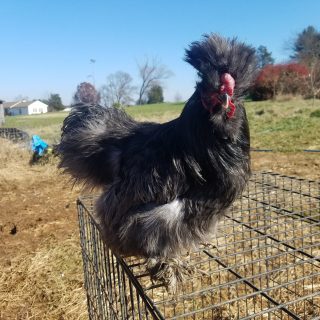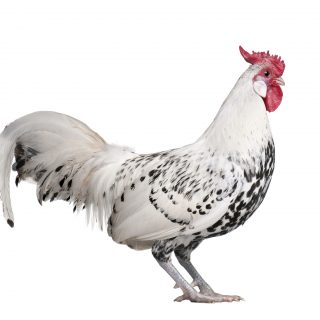Wanna add a little pizazz to your flock? Try the Swedish Flower Hen (no, they aren't all hens). Their beautiful, wide variety of patterns and good egg laying abilities make them a good candidate for anyone raising chickens.
Swedish Flower Hens (also known as Skånsk Blommehöna) are a landrace chicken originally from Sweden. They are a dual purpose bird who lay about 200 L - XL sized eggs per year. Additionally, they are very cold hardy and also are excellent foragers.
They also tend to be very healthy and easy to take care of.
Swedish Flower Hens are a rare chicken breed, but are growing in popularity. Before adding any to your flock read on to find out specifics about their temperament, care and other important qualities to assess if they are right right fit for you.
Swedish Flower Hen
| Size | Males: 6 - 8lbs; Females: around 5.5lbs |
| Class | Landrace |
| Color | Variety with base of red, blue, black and a flower pattern |
| Temperament | Calm & Intelligent |
| Hardiness | Cold |
| Eggs/Yr | 200 |
| Egg Size | L-XL |
| Egg Color | Cream/Beige to Light Brown |
History & Origin
Swedish Flower Hens originated in Sweden (shocker!). Their Swedish name is Skånsk Blommehöna.
Their exact history and origin is not well documented, this is due to the fact that they are a landrace breed. Like most landrace breeds, they have a diverse genetic background this is due to the fact that the breed developed through basically natural selection rather than a human (breeder) making breeding decisions based on a particular set of traits.
Essentially, the breed created itself by breeding together with whatever specimens tended to thrive in their area. This, in turn, created a very hardy and well-rounded breed.
However, one downfall of this is that since no one in particular was working with the breed, over time they were used less as other breeds were introduced which almost led to their extinction. Luckily, their declining numbers were caught in time and now people are working to restore the breed.
They were not imported into the US until around 2010. Since being introduced to the United States, they are slowly growing in popularity and more and more people are working with the breed which will help with their repopulation.
Need some help keeping your chickens health and care taken care of? Check out the Organized Chicken Keeper for an easy to follow system.
What Do They Look Like?
Due to the fact that this bred developed on its own moreso than having humans selecting certain traits, they do tend to have a bit of variation in the way that each chicken looks. There are some generally accepted traits that most all in the breed will have though.
They come in a wide variety of colors. Though they tend to have a blue, black or red base color. Most birds of this breed with have white wing tips, but not all do.
They get their name from the flower-like pattern that almost all of the birds will have. It is a millefleur pattern. This cover of flower-like shapes all over their feathers is really quite striking and makes them a nice bird to add to your flock if you are looking for something a bit on the flashy side.
There is one rare color called Snow Leopard in this breed that is not common at all. But is one of the more striking colors that shows up in Swedish Flower Hens.
They are sometimes a crested chicken (like Polish Chickens) and sometimes not crested.
They have a single red comb and red wattles, similar to a lot of other breeds such as Rhode Island Reds and Amberlinks.
The roosters tend to weigh in the 6 - 7 pound range while hens usually are around 5.5 pounds. This makes them a medium sized breed.
Their legs are yellow in color and do not have feathers (unlike Marans which are a feather legged breed). And they have four toes on each food (unlike Silkies which have 5 toes on each foot).
Breed Standards
This breed is not an accepted breed in the APA or most any other association, therefore they do not have a set breed standard. Some breeders are working to hopefully get them accepted at some time in the future.
Temperament
This breed tends to be calm, intelligent and friendly. They are not a lazy breed as they really enjoy foraging and moving around. But they are not super active or skiddish like Easter Eggers can tend to be.
They are fairly easy to handle due to their calmness and friendliness. Though they aren't always the bird that will be running up to you for attention. This is due to the fact that they tend to like doing their own thing and being independent (likely a trait developed during natural selection).
Since they are a landrace breed and spent a lot of time fending for themselves early on, they also tend to be alert and able to stay away from predators which works well during their foraging.
What is Their Purpose?
Though they are considered a dual purpose breed - they can be used for meat and eggs. They aren't one of the largest chicken breeds or the fastest maturing ones, so meat is not their main purpose. They can still certainly be used as a meat bird.
They are good egg layers laying around 3 - 4 cream to light brown colored eggs per week. Their initial eggs start out on the smaller side, but as they mature their eggs get larger. By their peak, they lay a Large to Extra Large sized egg.
In addition to eggs and meat, they make relatively good pets also. They tend to be calm and friendly which lends itself to being easy to handle.
Care & Health
The way that this breed was developed has created birds that are really very healthy and hardy. So, they don't really need much in the way of special care.
They of course, should have a good chicken coop and run (if they are not allowed to free-range). As well as your typical chicken waterers and chicken feeders.
It is rather cold where they originate from and this has made them an extremely cold hardy breed. So, great for colder climates.
They also love to forage (just like dorking chickens), which is a great way to cut down the chicken feed bill. So, if you have the room and ability to let them free-range they appreciate having the space to roam.
FAQ
What color eggs do Swedish flower hens lay?
They can lay a Cream/Beige to Light Brown colored egg.
What age do Swedish flower hens start laying?
They are usually ready to start laying eggs on the younger side so, in the 4 - 6 month range is pretty typical.
Are Swedish flower hens good layers?
Yes, they are good layers of L-XL eggs at about 3 - 4 per week. That amounts to about 156 - 208 eggs per year. Their first few eggs tend to be on the smaller size, but will get larger as the hen ages.
How much do Swedish flower hens cost?
They are a chicken that costs about the midrange of prices. So, for day old chicks, you'll typically see about $10 - $25 per chick, but prices can increase from there dependent on age, sex and quality.
How to tell a Swedish Flower Hen female from a rooster?
You can follow most of the typical ways to sex a chicken when you are trying to determine if you have a Swedish Flower Hen female or rooster. Roosters will have larger combs, wattles and legs. They will also have longer, pointer hackle and saddle feathers which also typically are more colorful.
If you need more help with taking care of your chickens, check out The Organized Chicken Keeper for a complete system for managing their health through keeping their supplies stocked and coop clean.


